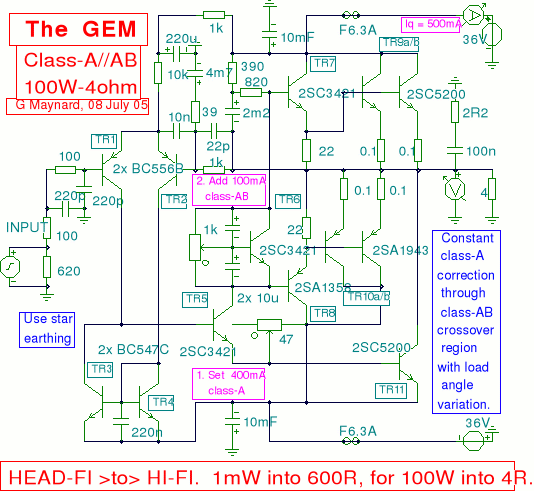A Class A // Class AB amplifier rated 100 Watts when driving a 4 ohm loudspeaker.

Notes:
This circuit developed out of my 30+ years of JLH class-A based investigations.
The original 'simple' 1969 JLH class-A design provided excellent first cycle accuracy through mid and high frequencies (dynamic clarity) because there were no stabilisation components nor a series output choke, whilst the NFB error correction was established via the input emitter (some describe this as current feedback).
However it did generate rather a lot of heat, the damping was 'soft' at lower frequencies and the positive slew was weaker in the presence of loudspeaker system generated back-EMF at higher audio frequencies. I was eventually able to improve upon the original JLH circuit by;-
1) adding a 'helper' class-AB output stage to substantially increase power and efficiency, but leave sufficient class-A bias for real-time control maintenance through phase shifted zero current class-AB crossovers;
2) adding a differential input stage for zero output voltage control, but also fit a 10nF base-emitter capacitor for differential voltage operation at audio frequencies, though with leading emitter routed feedback to maintain circuit stability and NFB control above 20kHz;
3) adding a current mirror to obviate power-up thump, but also fit a 220nF base-emitter capacitor to ensure stable 'source only' operation above audio frequencies.
Thus, when compared to conventional circuits, one complete high frequency phase change has been removed from the closed feedback loop in order to minimise need for any additional stabilisation components that would otherwise render the circuit inductive at audio frequencies. The original JLH hf (current feedback) stability and simultaneously phase coherent class-A control are retained.
This circuit was intended for 2SC5200 operation, yet it has been successfully constructed using other device types, including a single Sanken 2SA1216+2SC2922 pair in place of the paralleled ABs. Keep VAS, Zobel and output related wires 5cm/2" away from input devices and wiring. Use a star earth from the input location. Use star power distribution from each fused 10mF at the pcb. Use star output node connections. Parallel all large Cs with smaller ones. Do not twist any extender e-b-c wires that might be used out to heatsink mounted output stage devices. Mount the Vbe multiplier on the output heatsink for automatic temperature compensation. Adjust the class-AB pre-set to 50%, but adjust the class-A pre-set to be a short circuit before the initial switch-on. I recommend 22 ohm per rail in place of the fuses in case of error at initial power-up, but do not try to set any bias with them in circuit.
100W-4ohm (conservatively rated) is 50W-8ohm. For 70W/35W use 30V rails. For 50W/25W, 25V. For 100W-8ohm with higher voltage rails try a 47pF Miller connected C.dom to the VAS, it should compensate for device/stability changes with increased voltage, yet not adversely affect the class-A operation in maintaining crossover continuity. Always bias from zero current if you increase the rail voltage. Insert a 0.22 ohm series output resistor to maintain stability when driving purely capacitive loads, and don't forget to bi- or tri-wire out to composite loudspeaker system sections and drivers in order to obviate single cable developed dynamic voltage drops with varying loudspeaker system generated back-EMFs, no matter how expensive your loudspeaker cable might be.
Graham Maynard.
Terima kasih telah membaca artikel tentang Class-A//AB Amplifier di blog Indo Elektronika jika anda ingin menyebar luaskan artikel ini di mohon untuk mencantumkan link sebagai Sumbernya, dan bila artikel ini bermanfaat silakan bookmark halaman ini di web browser anda, dengan cara menekan Ctrl + D pada tombol keyboard anda.



